Station Operations
Scientific operations on CalCOFI cruises are scheduled 7/24 - around the clock 7 days a week. Scientists, technicians, and volunteers typically work 12hr shifts scheduled from noon to midnight or midnight to noon. In good weather, the ship transits at ~10kts to minimize ship noise in the fisheries acoustics data. Transits between stations 20nm (nautical miles; eg. 93.50 to 93.55) apart take ~2hrs; transits between stations 40nm apart (eg. 93.60 to 93.70) take ~4hrs at 10kts (1 'station unit' = 4nm). But transit times between stations are heavily influenced by sea state. Station time averages ~2.5 hours but vary depending on CTD cast depth & other station activities.
General Station Activities | General Seawater Sampling
Longer stations are:
- Daily, morning primary productivity stations (~3hrs; around local apparant noon);
- Basin stations (~3hrs, 2 per cruise: Santa Monica Basin & Santa Barbara Basin);
- 3500m deep CTD casts (~5hrs, 1 per cruise: Sta 90.90; 2nd may be performed on sta 80.90, time-permitting);
- DIC stations (~3hrs, 14 per cruise).
Shorter stations are:
- SCCOOS stations: nine 20m isobath coastal stations with a 15m CTD-Rosette cast, ~4 bottles closed and a 20m Bongo Net tow
- CalCOFI standard stations less than 515m deep; ~11 per 75 station cruise
Each standard CalCOFI station usually includes the following (move mouse over image for description):
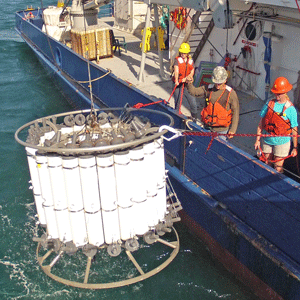 |
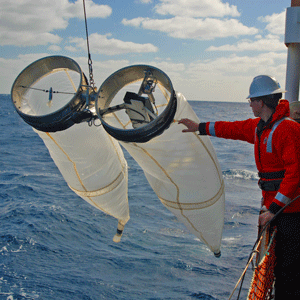 |
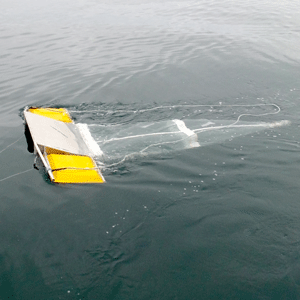 |
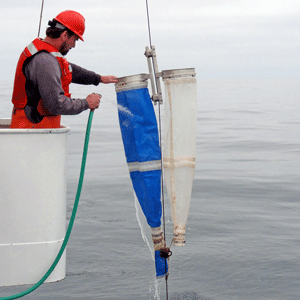 |
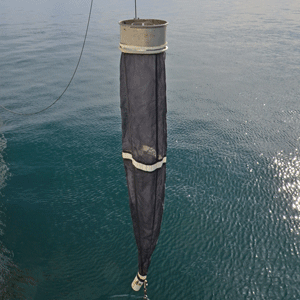 |
| 24-10L Bottle CTD-Rosette | Bongo w/ LOPC Net | Manta Net | Pairovet Vertical Net | PRPOOS Vertical Net |
- A Seabird 911+ CTD/Rosette consisting of 24-10 liter seawater sample bottles is lowered to 515 meters (1690ft; depth permitting) measuring physical parameters (temperature, salinity, oxygen, fluorescence, light transmittance, NO3 and PAR); bottles are closed at specific depths isolating seawater for analysis of: oxygen, salinity, nutrients, chlorophyll and phytoplankton.
- A Bongo net (CalBOBL) oblique plankton tow is performed at all CalCOFI stations. Tow specifications are: 300 meters of wire out, depth permitting, using paired 505 um mesh nets with 71 cm diameter openings; descent rate of 50 meters per minute; then ascending wire angles lower than 38 degrees or higher than 51 degrees in the final 100 meters of wire. A tow may be repeated if these criteria are not met. A 45 degrees wire angle should be closely maintained during the ascent and descent of the net frame. Additionally, the Bongo frame is fitted with a self-contained LOPC (Laser Optical Particle Counter) mounted inside the port side opening and flow meter in the starboard opening.
- A Manta net (neuston) tow is performed at all standard, non-SCCOOS stations, using a 505 um mesh net on a frame with a mouth area of 0.1333 m^2. The Manta net is towed at surface, sampling 8cm below the air-sea interface, for 15mins at ~1.5kts.
- A Pairovet (vertical) plankton tow is performed at all stations inshore of and including station 70. The Pairovet net fishes from 70 meters to the surface (depth permitting) using paired 25 cm diameter 150 um mesh nets. The technical requirements for Pairovet tows are: Descent rate of 70 meters per minute, ascent rate of 70 meters per minute. All tows with wire angles exceeding 15 degrees during the ascent will be repeated.
- A PRPOOS (Planktonic Rate Processes in Oligotrophic Ocean Systems) vertical net tow is performed at all stations on line 90.0 and 80.0 as well as stations out to and including station 70.0 on lines 86.7 and 83.3. These tows collect data for the LTER (Long Term Ecological Reserve) project. The mesh of the PRPOOS net is 202 um and the tow is a vertical cast up from 210 meters.
- Weather observations are tabulated during station, supplementing continuous data collected by shipboard integrated mesurement systems (MET/SCS) which collect continuous sea surface data. Wave size, direction, & period measurements are performed by the weather observer; these data are not available in the continuous integrated shipboard systems.
- Secchi disc measurements to determine the 1% light level are performed during daylight stations, weather-permitting.
- Primary productivity incubation experiment: at local apparent noon (LAN; ~11:30-12:20), each day of the cruise, a primary productivity incubation experiment is started with seawater samples collected from the CTD cast. Eighteen samples are drawn from six calculated light-level depths determined by the Secchi depth. Each seawater sample is inoculated with C14 and incubated from LAN to civil twilight at 6 different light levels, simulated 6 different ocean depths. Primary production is determined by C14 uptake by phytoplankton in these samples. Chlorophyll and phaeophytin concentrations are determined from 24hr cold acetone extraction fluorometric measurements of duplicate seawater samples. Nutrients are measured with an auto-analyzer. All 14C radioisotope work is done in a certified, isolated, radioisotope van; all areas are wipe tested multiple times before, during and after the cruise by SIO technical staff.
- Bird Observations: during transit between daytime stations, a bird observer records location and species of various sea birds.
- Marine Mammals Observations: during transit between daytime stations, two marine mammal observers visually identify marine mammals
- Marine Mammal Acoustics: during transit between daytime stations, a towed hydrophone array, monitored by an acoustician, records marine mammal vocalizations. On daytime stations, sonobuoys are deployed and monitored by an acoustician, recording marine mammal vocalizations.
- Fisheries Acoustics: throughout the cruise, EK60 and other frequency acoustic data are collected.
- CUFES: on Winter (~Jan), Spring (~Apr), and Summer (~Jul) CalCOFIs, the CUFES egg pump filters seawater from a depth of three meters. Seawater is pumped through an egg concentrator and sample are examined, preliminary egg counts are performed, and the samples are preserved for further analysis on-shore.
